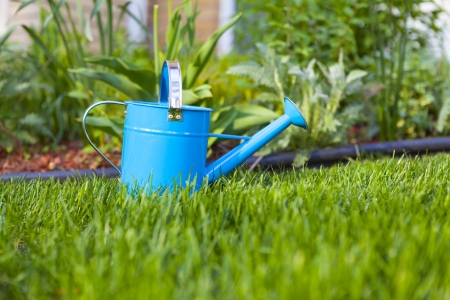1. What Is Drip Irrigation?
Drip irrigation is a low-pressure, water-efficient method of watering plants by delivering water directly to the root zone, drop by drop. Unlike traditional sprinklers that spray water over a wide area, drip systems use tubing, emitters, and valves to provide moisture exactly where its needed—right at the base of your plants.
How Does It Work?
The system typically consists of a main hose or tubing connected to a water source. Smaller tubes with emitters branch off from the main line and are placed near the roots of each plant. These emitters release small amounts of water slowly and steadily, allowing the soil to absorb moisture without runoff or evaporation.
Main Components of a Drip Irrigation System:
| Component | Description |
|---|---|
| Mainline Tubing | Carries water from the source to the garden beds |
| Emitters or Drippers | Deliver water directly to each plants root zone |
| Filters | Prevent debris from clogging the system |
| Pressure Regulator | Ensures consistent water pressure throughout the system |
| Connectors & Fittings | Used to customize the layout of your system |
Why Home Gardeners Across the U.S. Love It
Drip irrigation has become increasingly popular among American home gardeners for several reasons:
- Water Efficiency: Reduces water waste by targeting only where its needed.
- Saves Time: Once installed, it can be automated with timers for hands-free watering.
- Healthier Plants: Keeps foliage dry, reducing fungal diseases and rot.
- Adaptable: Works well for vegetable gardens, flower beds, raised beds, and even container plants.
- Cost-Effective: Lower water bills and minimal maintenance after setup.
A Growing Trend in Sustainable Gardening
As drought conditions and water restrictions become more common across parts of the U.S., especially in states like California and Arizona, many gardeners are turning to drip irrigation as a smart solution. Not only does it conserve water, but it also promotes healthier plant growth by keeping moisture levels consistent at the root level. Whether you’re growing tomatoes in Texas or flowers in Florida, drip irrigation offers a practical way to keep your garden thriving with less effort.
2. Benefits of Drip Irrigation for Home Gardens
Drip irrigation is becoming increasingly popular among home gardeners across the United States—and for good reason. This smart watering system delivers water directly to the base of your plants, offering a range of benefits that traditional sprinklers or hand-watering simply cant match. Let’s explore some of the top advantages of using drip irrigation in your backyard garden.
Water Conservation
One of the biggest perks of drip irrigation is how much water it saves. Unlike sprinklers that spray water everywhere (including onto sidewalks and driveways), drip systems target only the root zone. This means less water is lost to evaporation and runoff. In fact, drip irrigation can use up to 50% less water compared to traditional methods.
Healthier Plants
Because water is delivered slowly and directly to the roots, plants receive consistent moisture without being overwatered. This helps prevent common issues like root rot, mildew, and other fungal diseases that thrive in overly wet foliage. Healthier roots mean stronger, more productive plants—especially important if you’re growing vegetables or herbs.
Fewer Weeds
With traditional watering methods, you often end up watering everything—including weed seeds. Drip irrigation minimizes this by focusing moisture only where it’s needed. This targeted approach reduces weed growth around your plants, making garden maintenance easier and more efficient.
Time Savings
Drip irrigation systems can be connected to timers or smart controllers, so you dont have to spend time manually watering each day. This is especially helpful during hot summer months or if youre planning to be away from home. Once set up, your system does the work for you—saving you time and effort.
Main Benefits at a Glance
| Benefit | Description |
|---|---|
| Water Efficiency | Uses less water by targeting plant roots directly |
| Plant Health | Provides consistent moisture and reduces disease risk |
| Weed Control | Limits water exposure to weeds, reducing their growth |
| Saves Time | Automates watering with timers or smart systems |
A Smart Investment for Your Garden
If you’re looking for a low-maintenance, eco-friendly way to keep your garden thriving, drip irrigation is a great option. It not only conserves resources but also supports healthier plant growth—all while giving you back precious time in your day.
![]()
3. Choosing the Right Drip Irrigation System
Picking the best drip irrigation setup for your garden depends on what and where youre growing. Whether you’re tending to raised beds, vegetable patches, flower borders, or containers on your patio, there’s a drip system that fits just right. Let’s walk through the different types of gardens and which drip system components work best for each.
Raised Beds
Raised beds are great for keeping soil well-drained and organized. For these, a drip line with evenly spaced emitters is a solid choice. You can run lines along each row or zigzag them across the bed to ensure even watering.
Recommended Components:
- 1/2″ drip tubing with built-in emitters (every 12” is common)
- Barbed fittings for easy customization
- Pressure regulator to prevent damage from high water pressure
Vegetable Gardens
Vegetables often need consistent moisture, especially during fruiting or flowering stages. Use drip tape or emitter tubing that lets you control water delivery row by row.
Recommended Components:
- Drip tape for straight rows of crops like lettuce, carrots, or beans
- Adjustable emitters near larger plants like tomatoes or peppers
- Filter and pressure reducer to keep the system clean and steady
Flower Borders
Flower borders are usually more decorative and may include a mix of plant types. Flexible drip tubing with micro emitters allows you to customize placement around individual plants.
Recommended Components:
- 1/4″ tubing branches off mainline to reach individual plants
- Micro sprayers or bubblers for wider coverage in clustered plantings
- Timers to automate watering and avoid overwatering delicate blooms
Container Setups
If you have potted herbs on your deck or container flowers on your porch, small-scale systems are perfect. They’re easy to install and save time compared to hand-watering every day.
Recommended Components:
- 1/4″ tubing with adjustable drippers
- T-joints or manifolds to split water flow between pots
- Bottle adapters or gravity-fed kits for setups without a hose connection nearby
Quick Comparison Table:
| Garden Type | Best Drip Method | Main Benefits |
|---|---|---|
| Raised Beds | Tubing with inline emitters | Covers rows evenly; easy to scale up or down |
| Vegetable Gardens | Drip tape & adjustable emitters | Saves water; targets roots directly; ideal for crop rows |
| Flower Borders | Micro-sprayers & bubblers | Covers uneven spacing; protects delicate plants from overwatering |
| Potted Plants/Containers | Drippers via small tubing lines | Simplifies watering; works well in tight spaces or patios |
No matter the type of garden you have, theres a drip irrigation solution that fits your needs. Matching the right system to your space makes watering more efficient and gardening more enjoyable.
4. How to Install a Drip Irrigation System
Installing a drip irrigation system at home is easier than you might think. With a little planning and a few basic tools, you can set up an efficient watering system that saves time, water, and keeps your garden healthy. Follow these beginner-friendly steps using supplies you can find at most U.S. home improvement stores like Home Depot or Lowe’s.
Step 1: Plan Your Layout
Start by sketching your garden and identifying where your plants are located. Measure the distance between rows or plant groupings to determine how much tubing youll need.
Things to consider:
- Water source location (outdoor spigot)
- Plant types and their watering needs
- Sun exposure and soil type
Example Layout Planning Table
| Area | Type of Plants | Drip Line Needed | Emitter Spacing |
|---|---|---|---|
| Front Garden Bed | Tomatoes, Peppers | 15 ft tubing | Every 12 inches |
| Back Flower Border | Daisies, Lavender | 20 ft tubing | Every 18 inches |
| Raised Veggie Box | Lettuce, Spinach | 10 ft tubing | Every 6 inches |
Step 2: Gather Your Supplies
You can find all the necessary parts in a drip irrigation kit or buy them separately. Heres what youll typically need:
- Mainline tubing (usually 1/2″)
- Drip emitters or soaker lines
- Tubing stakes and connectors (tees, elbows, couplings)
- Pressure regulator (to control water pressure)
- Filter (to keep debris out)
- Backflow preventer (to protect drinking water supply)
- Punch tool (for inserting emitters)
- Timer (optional but helpful)
Step 3: Connect to Water Source
Screw the backflow preventer onto your outdoor faucet first, followed by the filter and pressure regulator. Then attach the mainline tubing. Make sure all connections are tight to avoid leaks.
Step 4: Lay Out the Tubing
Unroll your mainline tubing and lay it along your planned path. Use stakes to hold it down securely. If youre running multiple lines off the mainline, use tees or elbows to branch off into different sections.
Step 5: Add Emitters or Soaker Lines
Use the punch tool to make holes in the mainline tubing where each plant needs water. Insert emitters into each hole or connect micro-tubing with drippers for more precise watering.
Step 6: Test Your System
Turn on the water slowly and check each emitter to make sure its working properly. Look for leaks, clogs, or areas with too much or too little water flow. Make adjustments as needed.
Troubleshooting Tips:
- If no water comes out, check that all components are connected in the correct order.
- If emitters spray instead of drip, your water pressure may be too high—double-check your pressure regulator.
- If some plants aren’t getting enough water, consider adding more emitters or repositioning existing ones.
This step-by-step guide should help you get started with a simple yet effective drip irrigation system tailored to your home gardens needs.
5. Maintenance Tips and Troubleshooting
To keep your drip irrigation system working smoothly, its important to do regular maintenance and know how to fix common problems when they come up. A well-maintained system saves water, keeps plants healthy, and lasts much longer. Heres how to keep everything running efficiently.
Keep Your System Clean
Clogging is one of the most common issues with drip irrigation systems. This usually happens when dirt, algae, or mineral buildup blocks the emitters or tubing. To avoid this:
- Install a filter at the water source and clean it regularly.
- Flush the system once a month by opening end caps and letting water run through for a few minutes.
- If using fertilizer injectors, flush the lines afterward to prevent residue buildup.
Check for Leaks and Damage
Walk through your garden every couple of weeks to look for leaks, cracked tubing, or broken emitters. If you find any issues:
- Use goof plugs to seal small holes in tubing.
- Replace damaged sections with barbed connectors and new tubing.
- Tighten loose fittings around emitters or connectors.
Seasonal Care Tips by Climate Zone
The U.S. has a wide range of climates, so seasonal care will vary depending on where you live. Here’s a simple guide:
| Region | Winter Care | Summer Care |
|---|---|---|
| Northern States (e.g., Minnesota, New York) | Drain and store tubing indoors; cover outdoor connections | Inspect weekly for UV damage; water early morning or late evening |
| Southern States (e.g., Texas, Florida) | No draining needed; check for mold or overwatering during wet season | Adjust watering schedule during heatwaves; monitor for pests |
| Western States (e.g., California, Arizona) | Protect exposed parts from frost; reduce watering frequency | Check emitters more often due to dust; flush system monthly |
| Midwestern States (e.g., Illinois, Ohio) | Winterize system before first freeze; store removable parts | Watch for clogging due to hard water; consider water softeners |
Troubleshooting Common Issues
| Problem | Possible Cause | Solution |
|---|---|---|
| No water coming out of emitters | Clogged emitter or blocked tubing | Clean emitter or flush the tubing line |
| Uneven watering across garden | Poor pressure regulation or clogged lines | Add a pressure regulator and clean filters regularly |
| Puddles forming near plants | Overwatering or broken emitter | Adjust timing settings or replace faulty emitter |
A Few Extra Tips
- Label zones if you have multiple areas using different schedules.
- Avoid burying drip lines too deep—this makes inspection harder.
- If youre using timers, check batteries seasonally to ensure reliability.
A little upkeep goes a long way in keeping your drip irrigation system efficient and hassle-free all year round.


